Sainsbury's: Business Essentials, Marketing Mix and Strategy Review
VerifiedAdded on 2021/02/19
|7
|2442
|39
Report
AI Summary
This report provides a comprehensive analysis of Sainsbury's, one of the largest supermarket chains in the UK, focusing on its business essentials and marketing strategies. It begins with an introduction to the company, its subsidiaries, and its key competitors, including Tesco, ASDA, and Morrisons. The report then applies Porter's Five Forces to analyze Sainsbury's market position, examining competitive rivalry, the threat of substitutes, barriers to entry, buyer power, and supplier power. It also delves into the market size, structure, and nature of the market sector, identifying key issues such as online shopping trends and economic downturns, and the steps Sainsbury's is taking to address these challenges. Furthermore, the report explores Sainsbury's marketing mix, including product quality, pricing strategies, promotional activities, and place (distribution) strategies. The analysis highlights how Sainsbury's leverages the marketing mix to gain and maintain a competitive advantage in the retail sector, especially in response to changing consumer behaviors and technological advancements. The conclusion summarizes the key findings and suggests future directions for Sainsbury's growth, emphasizing the importance of technological integration and customer-centric strategies.
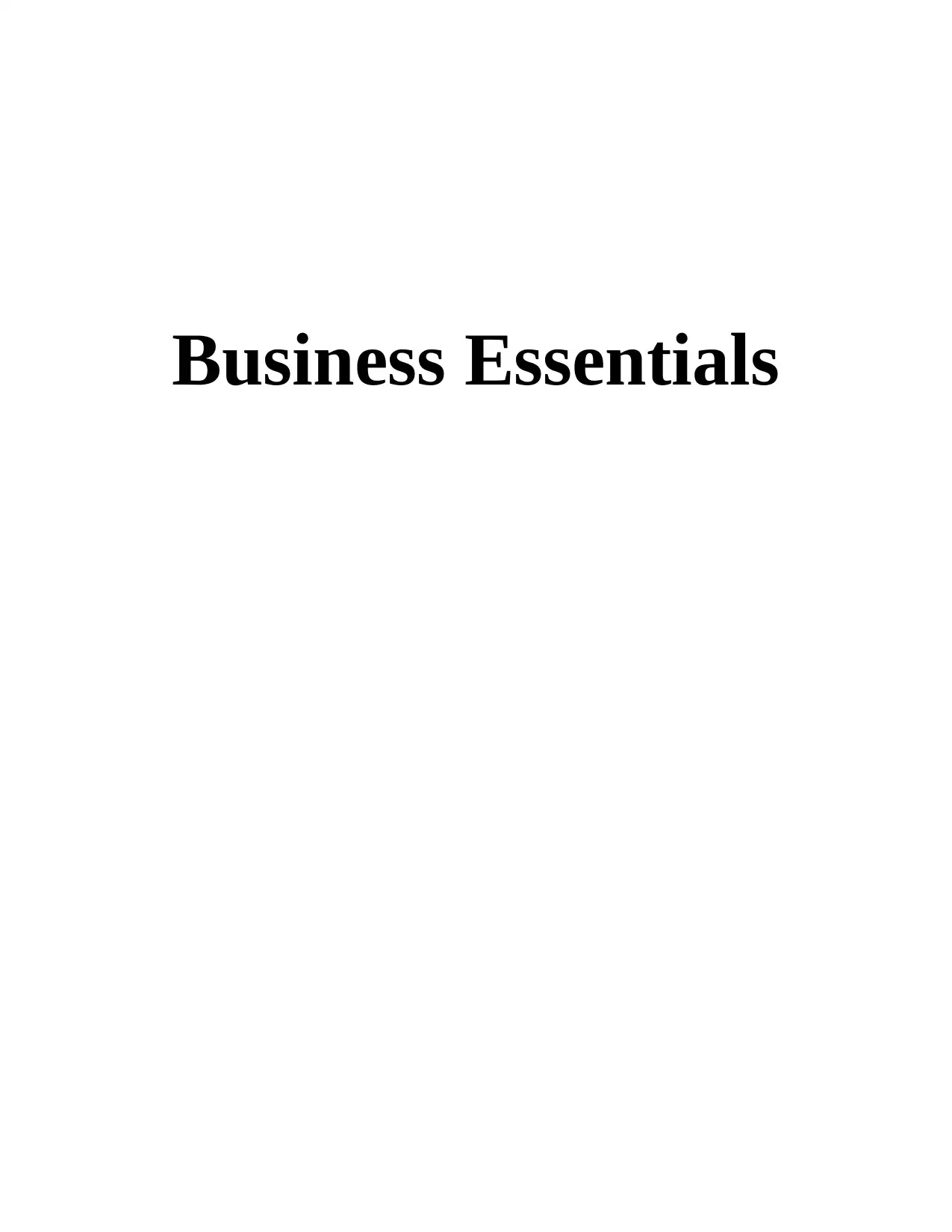
Business Essentials
Paraphrase This Document
Need a fresh take? Get an instant paraphrase of this document with our AI Paraphraser
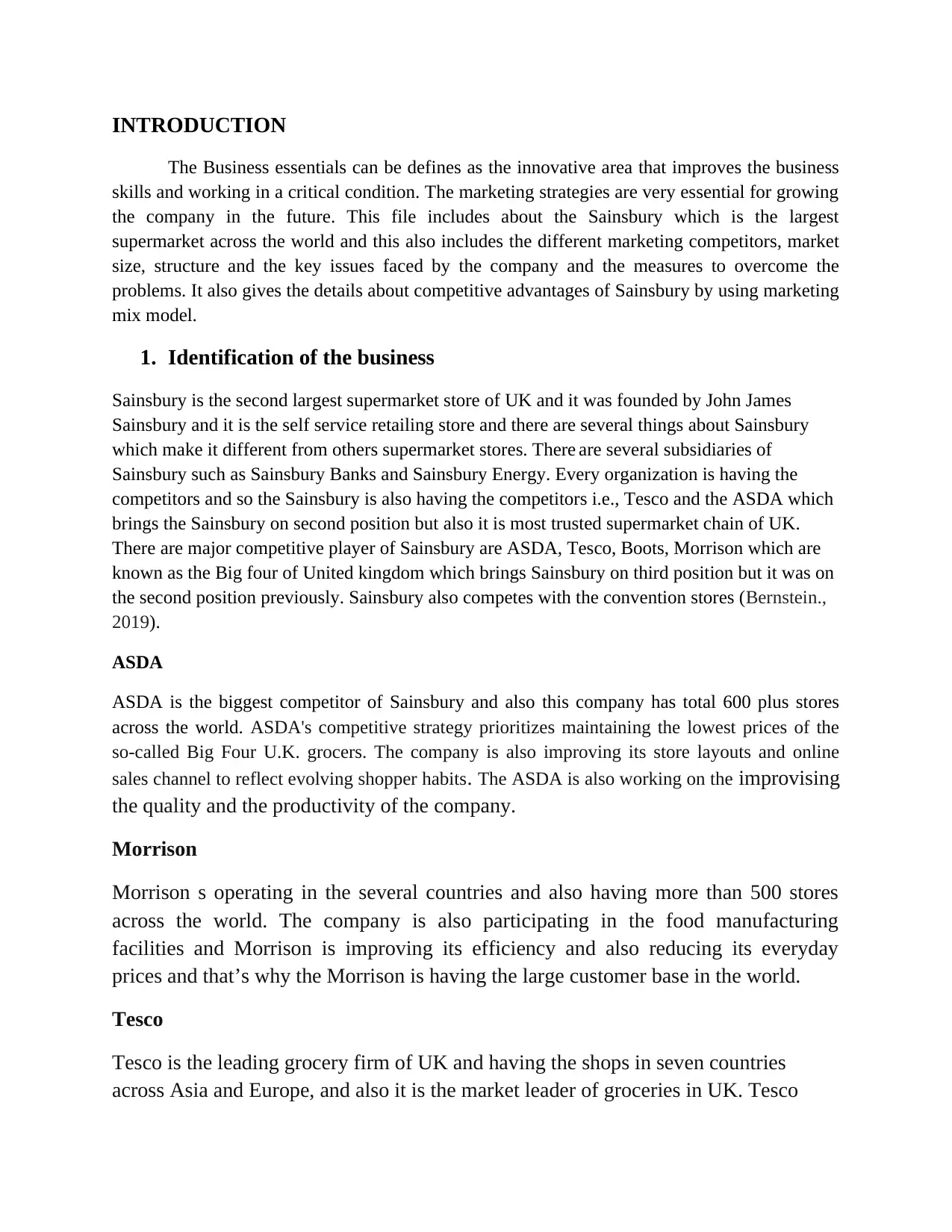
INTRODUCTION
The Business essentials can be defines as the innovative area that improves the business
skills and working in a critical condition. The marketing strategies are very essential for growing
the company in the future. This file includes about the Sainsbury which is the largest
supermarket across the world and this also includes the different marketing competitors, market
size, structure and the key issues faced by the company and the measures to overcome the
problems. It also gives the details about competitive advantages of Sainsbury by using marketing
mix model.
1. Identification of the business
Sainsbury is the second largest supermarket store of UK and it was founded by John James
Sainsbury and it is the self service retailing store and there are several things about Sainsbury
which make it different from others supermarket stores. There are several subsidiaries of
Sainsbury such as Sainsbury Banks and Sainsbury Energy. Every organization is having the
competitors and so the Sainsbury is also having the competitors i.e., Tesco and the ASDA which
brings the Sainsbury on second position but also it is most trusted supermarket chain of UK.
There are major competitive player of Sainsbury are ASDA, Tesco, Boots, Morrison which are
known as the Big four of United kingdom which brings Sainsbury on third position but it was on
the second position previously. Sainsbury also competes with the convention stores (Bernstein.,
2019).
ASDA
ASDA is the biggest competitor of Sainsbury and also this company has total 600 plus stores
across the world. ASDA's competitive strategy prioritizes maintaining the lowest prices of the
so-called Big Four U.K. grocers. The company is also improving its store layouts and online
sales channel to reflect evolving shopper habits. The ASDA is also working on the improvising
the quality and the productivity of the company.
Morrison
Morrison s operating in the several countries and also having more than 500 stores
across the world. The company is also participating in the food manufacturing
facilities and Morrison is improving its efficiency and also reducing its everyday
prices and that’s why the Morrison is having the large customer base in the world.
Tesco
Tesco is the leading grocery firm of UK and having the shops in seven countries
across Asia and Europe, and also it is the market leader of groceries in UK. Tesco
The Business essentials can be defines as the innovative area that improves the business
skills and working in a critical condition. The marketing strategies are very essential for growing
the company in the future. This file includes about the Sainsbury which is the largest
supermarket across the world and this also includes the different marketing competitors, market
size, structure and the key issues faced by the company and the measures to overcome the
problems. It also gives the details about competitive advantages of Sainsbury by using marketing
mix model.
1. Identification of the business
Sainsbury is the second largest supermarket store of UK and it was founded by John James
Sainsbury and it is the self service retailing store and there are several things about Sainsbury
which make it different from others supermarket stores. There are several subsidiaries of
Sainsbury such as Sainsbury Banks and Sainsbury Energy. Every organization is having the
competitors and so the Sainsbury is also having the competitors i.e., Tesco and the ASDA which
brings the Sainsbury on second position but also it is most trusted supermarket chain of UK.
There are major competitive player of Sainsbury are ASDA, Tesco, Boots, Morrison which are
known as the Big four of United kingdom which brings Sainsbury on third position but it was on
the second position previously. Sainsbury also competes with the convention stores (Bernstein.,
2019).
ASDA
ASDA is the biggest competitor of Sainsbury and also this company has total 600 plus stores
across the world. ASDA's competitive strategy prioritizes maintaining the lowest prices of the
so-called Big Four U.K. grocers. The company is also improving its store layouts and online
sales channel to reflect evolving shopper habits. The ASDA is also working on the improvising
the quality and the productivity of the company.
Morrison
Morrison s operating in the several countries and also having more than 500 stores
across the world. The company is also participating in the food manufacturing
facilities and Morrison is improving its efficiency and also reducing its everyday
prices and that’s why the Morrison is having the large customer base in the world.
Tesco
Tesco is the leading grocery firm of UK and having the shops in seven countries
across Asia and Europe, and also it is the market leader of groceries in UK. Tesco
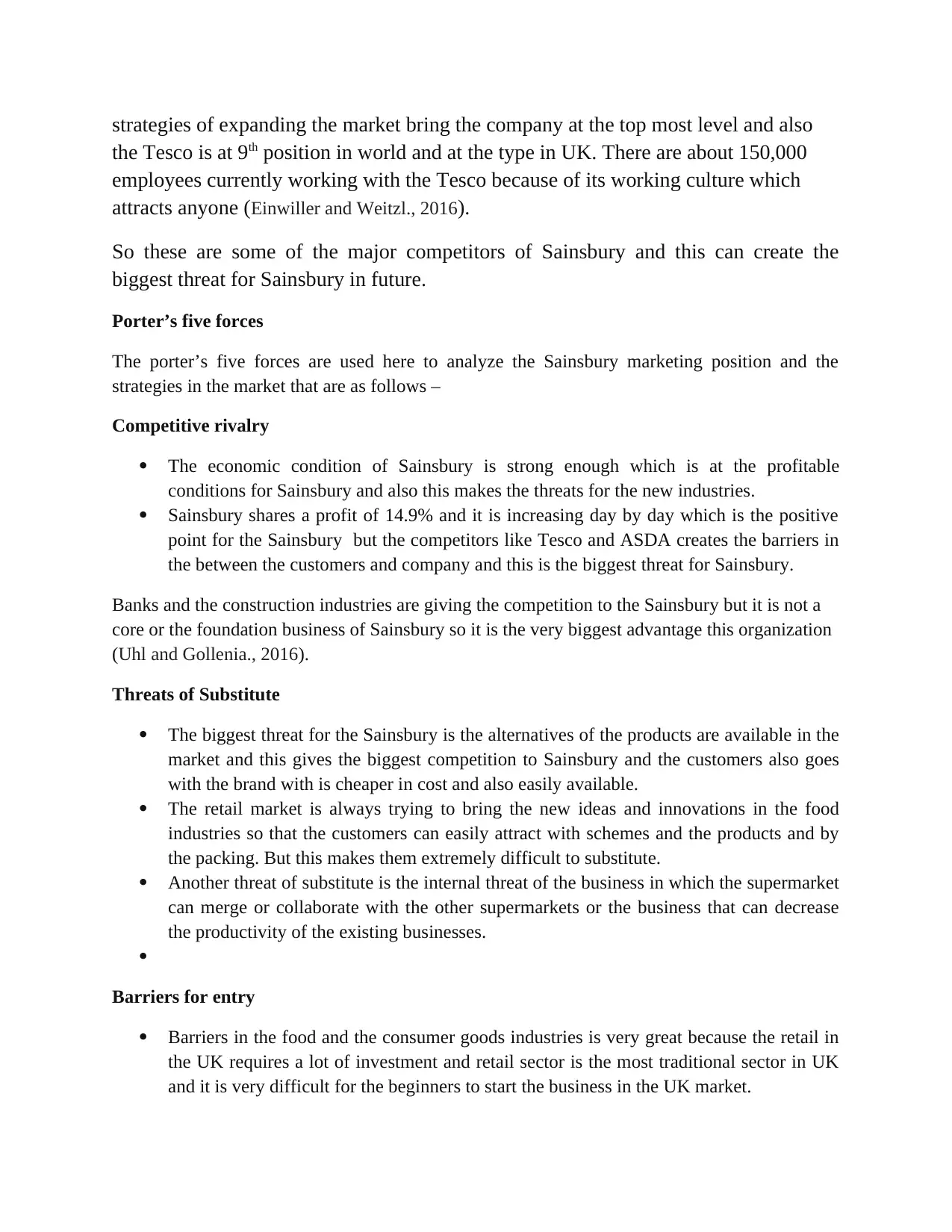
strategies of expanding the market bring the company at the top most level and also
the Tesco is at 9th position in world and at the type in UK. There are about 150,000
employees currently working with the Tesco because of its working culture which
attracts anyone (Einwiller and Weitzl., 2016).
So these are some of the major competitors of Sainsbury and this can create the
biggest threat for Sainsbury in future.
Porter’s five forces
The porter’s five forces are used here to analyze the Sainsbury marketing position and the
strategies in the market that are as follows –
Competitive rivalry
The economic condition of Sainsbury is strong enough which is at the profitable
conditions for Sainsbury and also this makes the threats for the new industries.
Sainsbury shares a profit of 14.9% and it is increasing day by day which is the positive
point for the Sainsbury but the competitors like Tesco and ASDA creates the barriers in
the between the customers and company and this is the biggest threat for Sainsbury.
Banks and the construction industries are giving the competition to the Sainsbury but it is not a
core or the foundation business of Sainsbury so it is the very biggest advantage this organization
(Uhl and Gollenia., 2016).
Threats of Substitute
The biggest threat for the Sainsbury is the alternatives of the products are available in the
market and this gives the biggest competition to Sainsbury and the customers also goes
with the brand with is cheaper in cost and also easily available.
The retail market is always trying to bring the new ideas and innovations in the food
industries so that the customers can easily attract with schemes and the products and by
the packing. But this makes them extremely difficult to substitute.
Another threat of substitute is the internal threat of the business in which the supermarket
can merge or collaborate with the other supermarkets or the business that can decrease
the productivity of the existing businesses.
Barriers for entry
Barriers in the food and the consumer goods industries is very great because the retail in
the UK requires a lot of investment and retail sector is the most traditional sector in UK
and it is very difficult for the beginners to start the business in the UK market.
the Tesco is at 9th position in world and at the type in UK. There are about 150,000
employees currently working with the Tesco because of its working culture which
attracts anyone (Einwiller and Weitzl., 2016).
So these are some of the major competitors of Sainsbury and this can create the
biggest threat for Sainsbury in future.
Porter’s five forces
The porter’s five forces are used here to analyze the Sainsbury marketing position and the
strategies in the market that are as follows –
Competitive rivalry
The economic condition of Sainsbury is strong enough which is at the profitable
conditions for Sainsbury and also this makes the threats for the new industries.
Sainsbury shares a profit of 14.9% and it is increasing day by day which is the positive
point for the Sainsbury but the competitors like Tesco and ASDA creates the barriers in
the between the customers and company and this is the biggest threat for Sainsbury.
Banks and the construction industries are giving the competition to the Sainsbury but it is not a
core or the foundation business of Sainsbury so it is the very biggest advantage this organization
(Uhl and Gollenia., 2016).
Threats of Substitute
The biggest threat for the Sainsbury is the alternatives of the products are available in the
market and this gives the biggest competition to Sainsbury and the customers also goes
with the brand with is cheaper in cost and also easily available.
The retail market is always trying to bring the new ideas and innovations in the food
industries so that the customers can easily attract with schemes and the products and by
the packing. But this makes them extremely difficult to substitute.
Another threat of substitute is the internal threat of the business in which the supermarket
can merge or collaborate with the other supermarkets or the business that can decrease
the productivity of the existing businesses.
Barriers for entry
Barriers in the food and the consumer goods industries is very great because the retail in
the UK requires a lot of investment and retail sector is the most traditional sector in UK
and it is very difficult for the beginners to start the business in the UK market.
⊘ This is a preview!⊘
Do you want full access?
Subscribe today to unlock all pages.

Trusted by 1+ million students worldwide
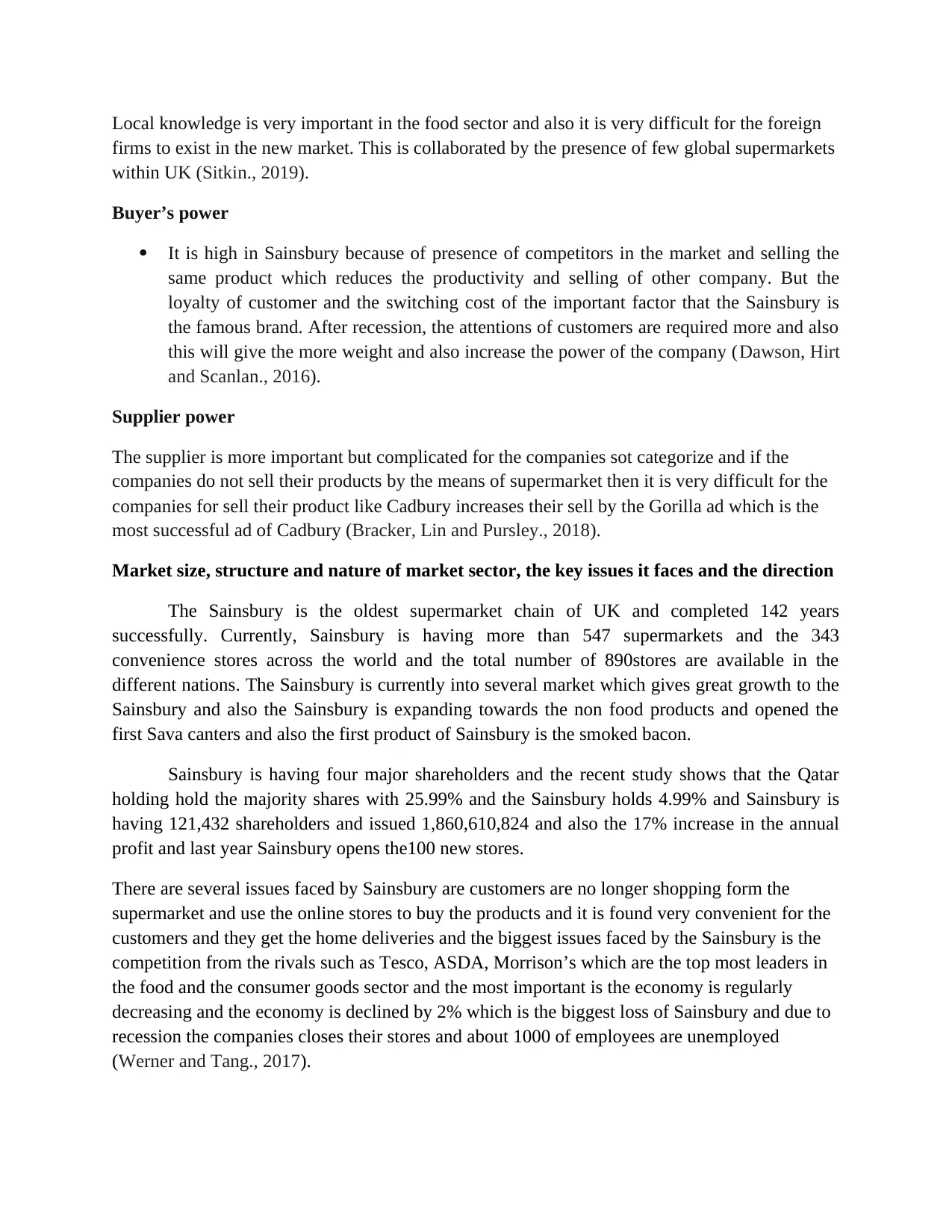
Local knowledge is very important in the food sector and also it is very difficult for the foreign
firms to exist in the new market. This is collaborated by the presence of few global supermarkets
within UK (Sitkin., 2019).
Buyer’s power
It is high in Sainsbury because of presence of competitors in the market and selling the
same product which reduces the productivity and selling of other company. But the
loyalty of customer and the switching cost of the important factor that the Sainsbury is
the famous brand. After recession, the attentions of customers are required more and also
this will give the more weight and also increase the power of the company (Dawson, Hirt
and Scanlan., 2016).
Supplier power
The supplier is more important but complicated for the companies sot categorize and if the
companies do not sell their products by the means of supermarket then it is very difficult for the
companies for sell their product like Cadbury increases their sell by the Gorilla ad which is the
most successful ad of Cadbury (Bracker, Lin and Pursley., 2018).
Market size, structure and nature of market sector, the key issues it faces and the direction
The Sainsbury is the oldest supermarket chain of UK and completed 142 years
successfully. Currently, Sainsbury is having more than 547 supermarkets and the 343
convenience stores across the world and the total number of 890stores are available in the
different nations. The Sainsbury is currently into several market which gives great growth to the
Sainsbury and also the Sainsbury is expanding towards the non food products and opened the
first Sava canters and also the first product of Sainsbury is the smoked bacon.
Sainsbury is having four major shareholders and the recent study shows that the Qatar
holding hold the majority shares with 25.99% and the Sainsbury holds 4.99% and Sainsbury is
having 121,432 shareholders and issued 1,860,610,824 and also the 17% increase in the annual
profit and last year Sainsbury opens the100 new stores.
There are several issues faced by Sainsbury are customers are no longer shopping form the
supermarket and use the online stores to buy the products and it is found very convenient for the
customers and they get the home deliveries and the biggest issues faced by the Sainsbury is the
competition from the rivals such as Tesco, ASDA, Morrison’s which are the top most leaders in
the food and the consumer goods sector and the most important is the economy is regularly
decreasing and the economy is declined by 2% which is the biggest loss of Sainsbury and due to
recession the companies closes their stores and about 1000 of employees are unemployed
(Werner and Tang., 2017).
firms to exist in the new market. This is collaborated by the presence of few global supermarkets
within UK (Sitkin., 2019).
Buyer’s power
It is high in Sainsbury because of presence of competitors in the market and selling the
same product which reduces the productivity and selling of other company. But the
loyalty of customer and the switching cost of the important factor that the Sainsbury is
the famous brand. After recession, the attentions of customers are required more and also
this will give the more weight and also increase the power of the company (Dawson, Hirt
and Scanlan., 2016).
Supplier power
The supplier is more important but complicated for the companies sot categorize and if the
companies do not sell their products by the means of supermarket then it is very difficult for the
companies for sell their product like Cadbury increases their sell by the Gorilla ad which is the
most successful ad of Cadbury (Bracker, Lin and Pursley., 2018).
Market size, structure and nature of market sector, the key issues it faces and the direction
The Sainsbury is the oldest supermarket chain of UK and completed 142 years
successfully. Currently, Sainsbury is having more than 547 supermarkets and the 343
convenience stores across the world and the total number of 890stores are available in the
different nations. The Sainsbury is currently into several market which gives great growth to the
Sainsbury and also the Sainsbury is expanding towards the non food products and opened the
first Sava canters and also the first product of Sainsbury is the smoked bacon.
Sainsbury is having four major shareholders and the recent study shows that the Qatar
holding hold the majority shares with 25.99% and the Sainsbury holds 4.99% and Sainsbury is
having 121,432 shareholders and issued 1,860,610,824 and also the 17% increase in the annual
profit and last year Sainsbury opens the100 new stores.
There are several issues faced by Sainsbury are customers are no longer shopping form the
supermarket and use the online stores to buy the products and it is found very convenient for the
customers and they get the home deliveries and the biggest issues faced by the Sainsbury is the
competition from the rivals such as Tesco, ASDA, Morrison’s which are the top most leaders in
the food and the consumer goods sector and the most important is the economy is regularly
decreasing and the economy is declined by 2% which is the biggest loss of Sainsbury and due to
recession the companies closes their stores and about 1000 of employees are unemployed
(Werner and Tang., 2017).
Paraphrase This Document
Need a fresh take? Get an instant paraphrase of this document with our AI Paraphraser
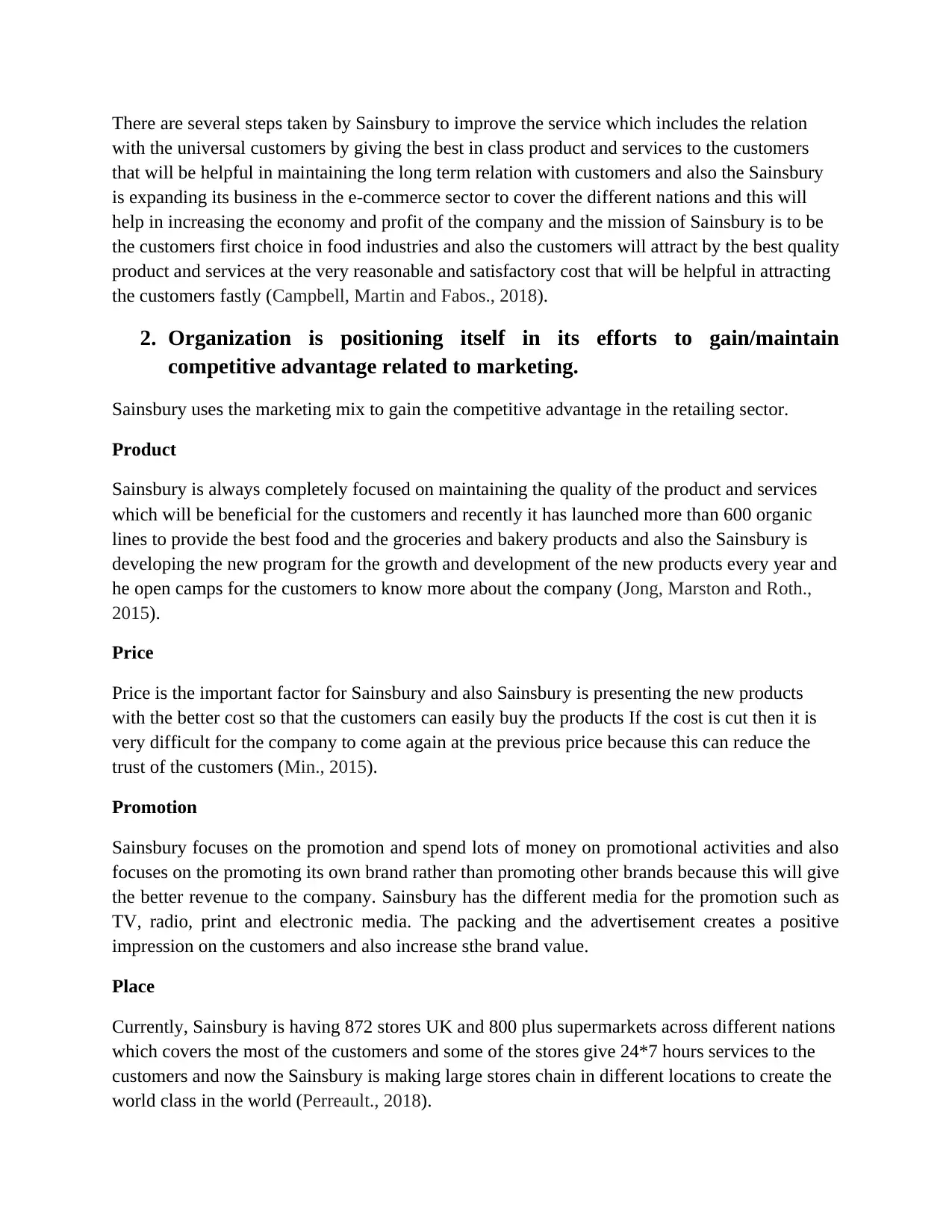
There are several steps taken by Sainsbury to improve the service which includes the relation
with the universal customers by giving the best in class product and services to the customers
that will be helpful in maintaining the long term relation with customers and also the Sainsbury
is expanding its business in the e-commerce sector to cover the different nations and this will
help in increasing the economy and profit of the company and the mission of Sainsbury is to be
the customers first choice in food industries and also the customers will attract by the best quality
product and services at the very reasonable and satisfactory cost that will be helpful in attracting
the customers fastly (Campbell, Martin and Fabos., 2018).
2. Organization is positioning itself in its efforts to gain/maintain
competitive advantage related to marketing.
Sainsbury uses the marketing mix to gain the competitive advantage in the retailing sector.
Product
Sainsbury is always completely focused on maintaining the quality of the product and services
which will be beneficial for the customers and recently it has launched more than 600 organic
lines to provide the best food and the groceries and bakery products and also the Sainsbury is
developing the new program for the growth and development of the new products every year and
he open camps for the customers to know more about the company (Jong, Marston and Roth.,
2015).
Price
Price is the important factor for Sainsbury and also Sainsbury is presenting the new products
with the better cost so that the customers can easily buy the products If the cost is cut then it is
very difficult for the company to come again at the previous price because this can reduce the
trust of the customers (Min., 2015).
Promotion
Sainsbury focuses on the promotion and spend lots of money on promotional activities and also
focuses on the promoting its own brand rather than promoting other brands because this will give
the better revenue to the company. Sainsbury has the different media for the promotion such as
TV, radio, print and electronic media. The packing and the advertisement creates a positive
impression on the customers and also increase sthe brand value.
Place
Currently, Sainsbury is having 872 stores UK and 800 plus supermarkets across different nations
which covers the most of the customers and some of the stores give 24*7 hours services to the
customers and now the Sainsbury is making large stores chain in different locations to create the
world class in the world (Perreault., 2018).
with the universal customers by giving the best in class product and services to the customers
that will be helpful in maintaining the long term relation with customers and also the Sainsbury
is expanding its business in the e-commerce sector to cover the different nations and this will
help in increasing the economy and profit of the company and the mission of Sainsbury is to be
the customers first choice in food industries and also the customers will attract by the best quality
product and services at the very reasonable and satisfactory cost that will be helpful in attracting
the customers fastly (Campbell, Martin and Fabos., 2018).
2. Organization is positioning itself in its efforts to gain/maintain
competitive advantage related to marketing.
Sainsbury uses the marketing mix to gain the competitive advantage in the retailing sector.
Product
Sainsbury is always completely focused on maintaining the quality of the product and services
which will be beneficial for the customers and recently it has launched more than 600 organic
lines to provide the best food and the groceries and bakery products and also the Sainsbury is
developing the new program for the growth and development of the new products every year and
he open camps for the customers to know more about the company (Jong, Marston and Roth.,
2015).
Price
Price is the important factor for Sainsbury and also Sainsbury is presenting the new products
with the better cost so that the customers can easily buy the products If the cost is cut then it is
very difficult for the company to come again at the previous price because this can reduce the
trust of the customers (Min., 2015).
Promotion
Sainsbury focuses on the promotion and spend lots of money on promotional activities and also
focuses on the promoting its own brand rather than promoting other brands because this will give
the better revenue to the company. Sainsbury has the different media for the promotion such as
TV, radio, print and electronic media. The packing and the advertisement creates a positive
impression on the customers and also increase sthe brand value.
Place
Currently, Sainsbury is having 872 stores UK and 800 plus supermarkets across different nations
which covers the most of the customers and some of the stores give 24*7 hours services to the
customers and now the Sainsbury is making large stores chain in different locations to create the
world class in the world (Perreault., 2018).
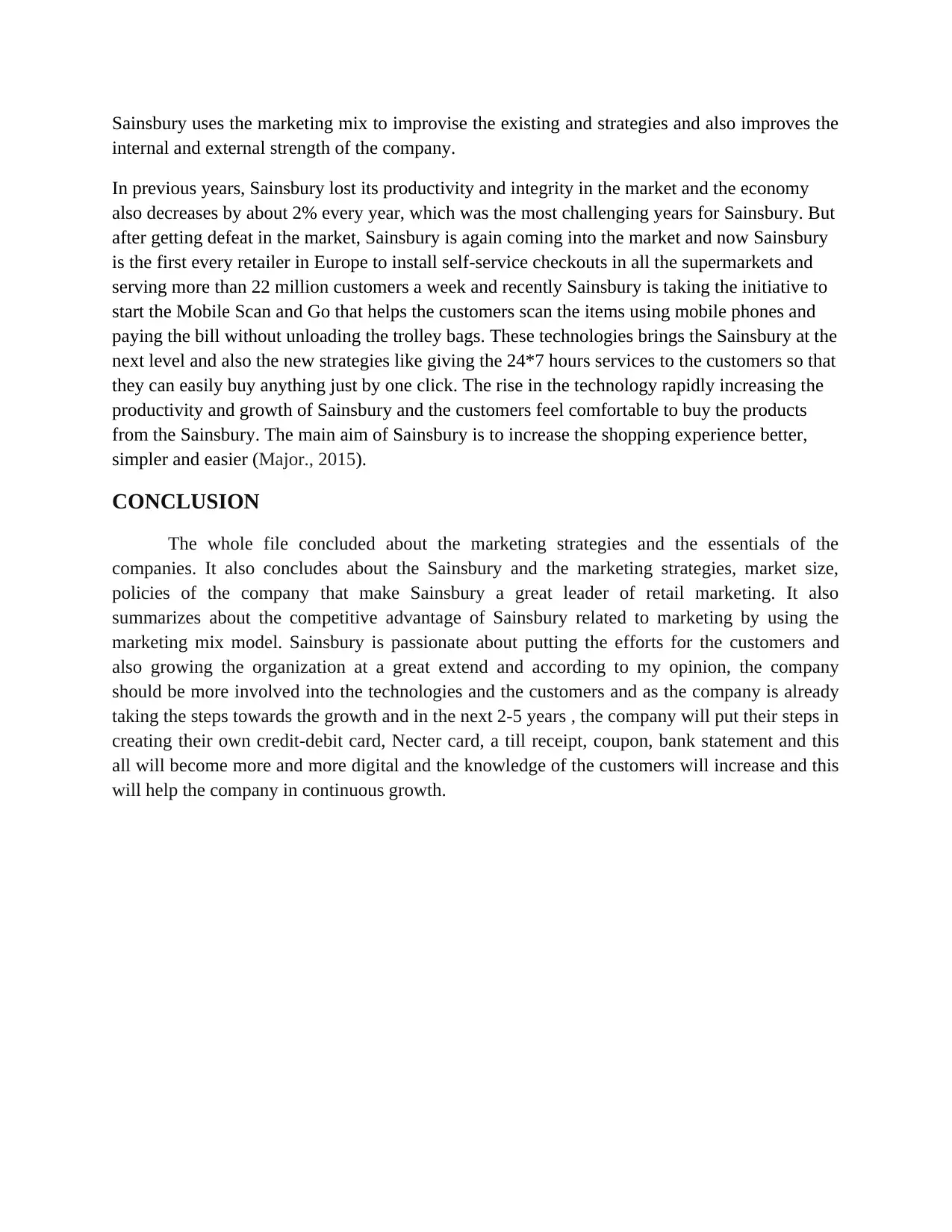
Sainsbury uses the marketing mix to improvise the existing and strategies and also improves the
internal and external strength of the company.
In previous years, Sainsbury lost its productivity and integrity in the market and the economy
also decreases by about 2% every year, which was the most challenging years for Sainsbury. But
after getting defeat in the market, Sainsbury is again coming into the market and now Sainsbury
is the first every retailer in Europe to install self-service checkouts in all the supermarkets and
serving more than 22 million customers a week and recently Sainsbury is taking the initiative to
start the Mobile Scan and Go that helps the customers scan the items using mobile phones and
paying the bill without unloading the trolley bags. These technologies brings the Sainsbury at the
next level and also the new strategies like giving the 24*7 hours services to the customers so that
they can easily buy anything just by one click. The rise in the technology rapidly increasing the
productivity and growth of Sainsbury and the customers feel comfortable to buy the products
from the Sainsbury. The main aim of Sainsbury is to increase the shopping experience better,
simpler and easier (Major., 2015).
CONCLUSION
The whole file concluded about the marketing strategies and the essentials of the
companies. It also concludes about the Sainsbury and the marketing strategies, market size,
policies of the company that make Sainsbury a great leader of retail marketing. It also
summarizes about the competitive advantage of Sainsbury related to marketing by using the
marketing mix model. Sainsbury is passionate about putting the efforts for the customers and
also growing the organization at a great extend and according to my opinion, the company
should be more involved into the technologies and the customers and as the company is already
taking the steps towards the growth and in the next 2-5 years , the company will put their steps in
creating their own credit-debit card, Necter card, a till receipt, coupon, bank statement and this
all will become more and more digital and the knowledge of the customers will increase and this
will help the company in continuous growth.
internal and external strength of the company.
In previous years, Sainsbury lost its productivity and integrity in the market and the economy
also decreases by about 2% every year, which was the most challenging years for Sainsbury. But
after getting defeat in the market, Sainsbury is again coming into the market and now Sainsbury
is the first every retailer in Europe to install self-service checkouts in all the supermarkets and
serving more than 22 million customers a week and recently Sainsbury is taking the initiative to
start the Mobile Scan and Go that helps the customers scan the items using mobile phones and
paying the bill without unloading the trolley bags. These technologies brings the Sainsbury at the
next level and also the new strategies like giving the 24*7 hours services to the customers so that
they can easily buy anything just by one click. The rise in the technology rapidly increasing the
productivity and growth of Sainsbury and the customers feel comfortable to buy the products
from the Sainsbury. The main aim of Sainsbury is to increase the shopping experience better,
simpler and easier (Major., 2015).
CONCLUSION
The whole file concluded about the marketing strategies and the essentials of the
companies. It also concludes about the Sainsbury and the marketing strategies, market size,
policies of the company that make Sainsbury a great leader of retail marketing. It also
summarizes about the competitive advantage of Sainsbury related to marketing by using the
marketing mix model. Sainsbury is passionate about putting the efforts for the customers and
also growing the organization at a great extend and according to my opinion, the company
should be more involved into the technologies and the customers and as the company is already
taking the steps towards the growth and in the next 2-5 years , the company will put their steps in
creating their own credit-debit card, Necter card, a till receipt, coupon, bank statement and this
all will become more and more digital and the knowledge of the customers will increase and this
will help the company in continuous growth.
⊘ This is a preview!⊘
Do you want full access?
Subscribe today to unlock all pages.

Trusted by 1+ million students worldwide
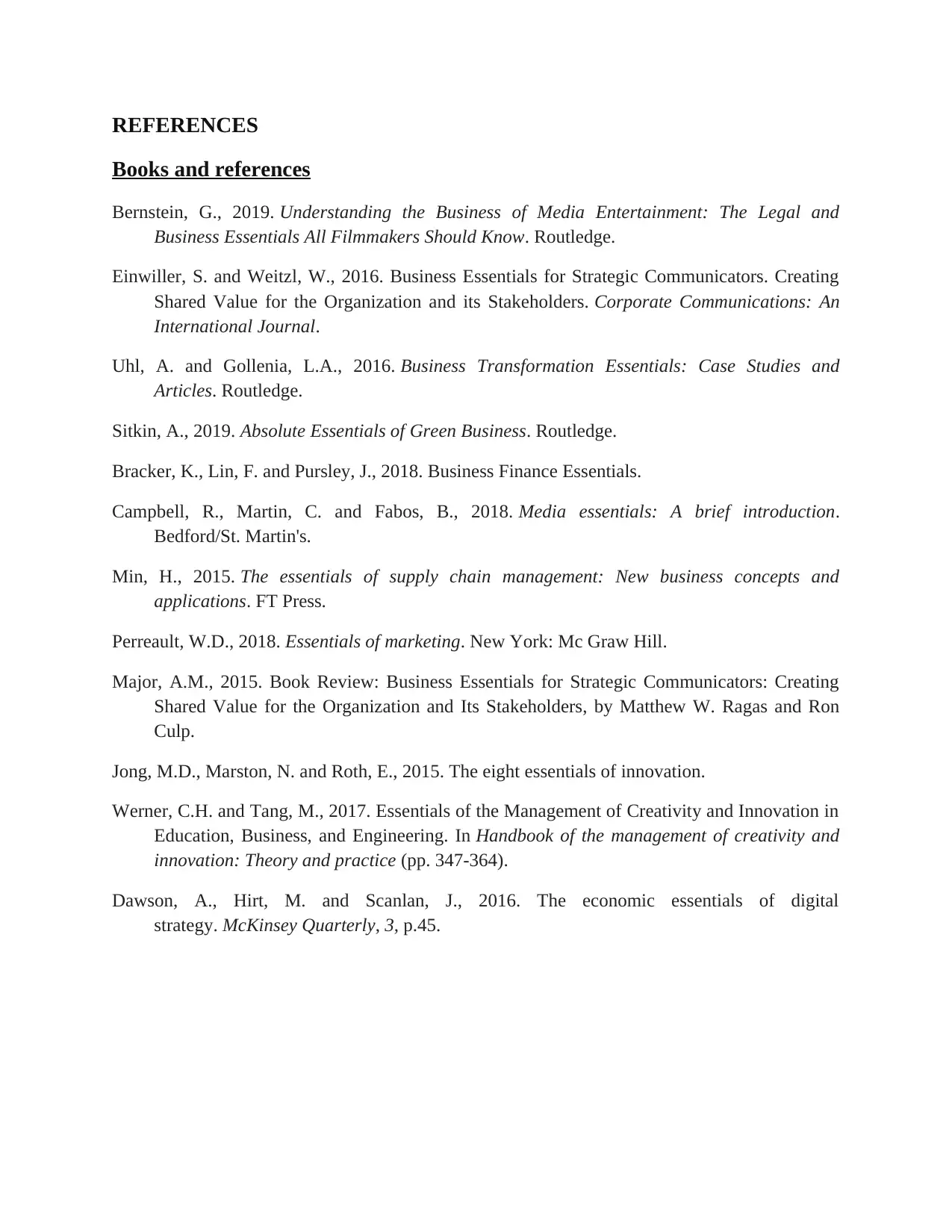
REFERENCES
Books and references
Bernstein, G., 2019. Understanding the Business of Media Entertainment: The Legal and
Business Essentials All Filmmakers Should Know. Routledge.
Einwiller, S. and Weitzl, W., 2016. Business Essentials for Strategic Communicators. Creating
Shared Value for the Organization and its Stakeholders. Corporate Communications: An
International Journal.
Uhl, A. and Gollenia, L.A., 2016. Business Transformation Essentials: Case Studies and
Articles. Routledge.
Sitkin, A., 2019. Absolute Essentials of Green Business. Routledge.
Bracker, K., Lin, F. and Pursley, J., 2018. Business Finance Essentials.
Campbell, R., Martin, C. and Fabos, B., 2018. Media essentials: A brief introduction.
Bedford/St. Martin's.
Min, H., 2015. The essentials of supply chain management: New business concepts and
applications. FT Press.
Perreault, W.D., 2018. Essentials of marketing. New York: Mc Graw Hill.
Major, A.M., 2015. Book Review: Business Essentials for Strategic Communicators: Creating
Shared Value for the Organization and Its Stakeholders, by Matthew W. Ragas and Ron
Culp.
Jong, M.D., Marston, N. and Roth, E., 2015. The eight essentials of innovation.
Werner, C.H. and Tang, M., 2017. Essentials of the Management of Creativity and Innovation in
Education, Business, and Engineering. In Handbook of the management of creativity and
innovation: Theory and practice (pp. 347-364).
Dawson, A., Hirt, M. and Scanlan, J., 2016. The economic essentials of digital
strategy. McKinsey Quarterly, 3, p.45.
Books and references
Bernstein, G., 2019. Understanding the Business of Media Entertainment: The Legal and
Business Essentials All Filmmakers Should Know. Routledge.
Einwiller, S. and Weitzl, W., 2016. Business Essentials for Strategic Communicators. Creating
Shared Value for the Organization and its Stakeholders. Corporate Communications: An
International Journal.
Uhl, A. and Gollenia, L.A., 2016. Business Transformation Essentials: Case Studies and
Articles. Routledge.
Sitkin, A., 2019. Absolute Essentials of Green Business. Routledge.
Bracker, K., Lin, F. and Pursley, J., 2018. Business Finance Essentials.
Campbell, R., Martin, C. and Fabos, B., 2018. Media essentials: A brief introduction.
Bedford/St. Martin's.
Min, H., 2015. The essentials of supply chain management: New business concepts and
applications. FT Press.
Perreault, W.D., 2018. Essentials of marketing. New York: Mc Graw Hill.
Major, A.M., 2015. Book Review: Business Essentials for Strategic Communicators: Creating
Shared Value for the Organization and Its Stakeholders, by Matthew W. Ragas and Ron
Culp.
Jong, M.D., Marston, N. and Roth, E., 2015. The eight essentials of innovation.
Werner, C.H. and Tang, M., 2017. Essentials of the Management of Creativity and Innovation in
Education, Business, and Engineering. In Handbook of the management of creativity and
innovation: Theory and practice (pp. 347-364).
Dawson, A., Hirt, M. and Scanlan, J., 2016. The economic essentials of digital
strategy. McKinsey Quarterly, 3, p.45.
1 out of 7
Related Documents
Your All-in-One AI-Powered Toolkit for Academic Success.
+13062052269
info@desklib.com
Available 24*7 on WhatsApp / Email
![[object Object]](/_next/static/media/star-bottom.7253800d.svg)
Unlock your academic potential
Copyright © 2020–2025 A2Z Services. All Rights Reserved. Developed and managed by ZUCOL.




